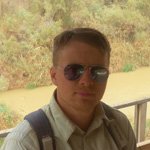Khyber Pass in Pakistan
Khyber Pass in Pakistan
Khyber Pass is a road leading through mountains from the city of Peshawar in Pakistan to Afghanistan. This dangerous section is the main trade route to Afghanistan, which has a reputation of being outside of the Pakistani law, and it is a place of many surprises. When I was there in 2006 I was told that the area was controlled by Pashtuns (an ethnic minority from Afghanistan), but I know that the Taliban also controlled this strategic trade route. Khyber Pass is a place of constant fight for influence between the forces of the Pakistani government, the Taliban, and the local Pashtun tribes. From the point of view of tourism Khyber Pass is a big challenge, but I had the strength and the spirit to fulfill this unforgettable adventure with a company of an armed guide. During my trip I also had many interesting conversations, which were interesting because they were with people, who were not force fed with the Western propaganda.
Khyber Pass 2006
First of all, ask yourself this question why you want to go to the areas where security is very uncertain. Well, some travelers need more challenges than just beaches in Thailand. Khyber Pass is an adventure with a thrill, which despite its popular opinion about Afghan refugee camps, counterfeit weapon factories or blockades of this route arranged by the Taliban, before the war attracted thousands of tourists.
There are British monuments and forts along Khyber Pass, and it was there where Alexander the Great led his army. When it comes to the natural beauty, Khyber Pass is also attractive because it is located in the Hindu Kush mountain range, and its highest point lies at an altitude of 1070 m above the sea level. During the war in Afghanistan, it was the strategic Khyber Pass, through which 80% of goods were delivered to Afghanistan, as well as UN troops, weapons and forces supporting the Taliban. Officially, the 53 km long Khyber Pass is the transition between South Asia and Central Asia.

A popular joke in Pakistan. My guide was pointing at me from AK-47, near Afghanistan.
Will the war come back to Khyber Pass? I think for sure because it is such a strategically important place that different organizations will always fight for influence. Currently, the Pakistani Government in Islamabad pays Pashtuns to maintain relative security over there, but no one knows how long it would take. England fought over there against Russia, and the Taliban against the Americans. Al-Qaeda, Pakistani troops, various Pashtun tribes, and maybe even aliens also fought in Khyber Pass. I’m not an expert, but I think the situation can change quickly.
Khyber Pass is therefore a very attractive place for tourists because of its history, natural beauty and very interesting people who live in these areas. One can go to the Afghan Refugee Camp, visit a weapon factory, see local craftsmen at work, and see little Pakistani boys painting trucks. However, I always advise to take an armed guide from the local police and to not go to far from the road. Travelers with Afghan visas continue their journey through mountain serpentines straight to Afghanistan, but my last stop was the Michni checkpoint. It is also possible to go to Peshawar by taxi from Kabul.
Peshawar
Peshawar is a city located in the west of Pakistan, only 58km from the border with Afghanistan, on the eastern part of the historic Khyber Pass trade route. Peshawar is the oldest city in Pakistan, and one of the oldest cities in South Asia, whose written sources date back to 539 BC. Peshawar is inhabited by about 2 million people, and what’s important it has the largest population of Pashtuns in Pakistan. Peshawar changed owners quite often, because the city was conquered by various Muslim empires, by the Sikhs, and also by the British. Because of this, Peshawar is a historic city with many monuments, although I found it to be very interesting also due to its specific character. Peshawar has many mosques that were built at different times by different rulers, and that’s why they differ in style. For example, the British built two richly decorated universities and an attractive clock tower. (I mention this in case the White Guilt propagandists saw only evil in the British Empire.)
I remember that everyone had warned me about Peshawar and said, that it was dangerous. They told me horror stories that it was a city of terrorists, and the Polish embassy advised to not to go there. I finally understood what the British and the Polish Ministry of Foreign Affairs had in common. They exist to frighten those people who want to go on vacation.

With my guide in Peshawar, Pakistan. The action photo by night.
To me however, Peshawar was not interesting only because of the monuments, but because of the interesting nature of the city and its people. The streets were not very clean, and passing buses created a lot of dust on the road. It’s a miracle that those cars didn’t fall apart. I liked the old buildings with wooden balconies, and small shops run by Pakistanis and Afghans. I also went to the famous Qissa Khavani bazaar, which I recommend especially because of the company of interesting people, and sometimes also goats.
In Peshawar me and my travel companion stayed in the best cheap hotel, where we had such luxury as carpet on the floor and hot water at will. When we entered the room, a few minutes later a travel agent knocked the door and offered trips. It was a young Pakistani man Hussain, who came with a catalog in his hand, to show us local attractions. However, these were not trips that we would usually imagine. Hussain said that these trips are organized to the Pashtun areas, where people have their own rules. Immediately when Peshawar ends, there is an area within a 45km radius of the border with Afghanistan, which lies on the territory of Pakistan but the law of this country does not reach there, and therefore foreigners are not allowed there, unless with a special permit and with an armed policeman. I wasn’t sure if this was a good place for my traveling companion, but I wanted to go there anyway, especially that I saw comments of so many people who went there before and returned.
That same evening our travel agent Hussain showed us around the Old Town. Peshawar was dirty and dark but had its own specific atmosphere. The whole city looked as if a bomb had just exploded there, but it was only my imagination dictated by the Western media, because apparently everything was all right. In Peshawar there are the most refugees from Afghanistan who sell their carpets and bracelets, and who offer guided tours to Afghanistan. I know that a lot of people go there on vacation and come back, but this time I did’t want to take a risk because I was with a woman, and I did’t prepare properly for such a trip. Hussain invited us to a very old tea room in a destroyed house on the first floor, where Monika was afraid to enter, especially that the lights went out. As I said before, there are many places in Pakistan that despite being safe work on the imagination, but green tea in that place was delicious. Hussain added that electricity always goes out in this tea house; even though in my opinion it rather looked like a tragic homeless shelter.

Tea shop in Peshawar. Pakistan.
Hussain showed us around the Old Town and he also showed many other interesting places. I think that the Peshawar Old Town is definitely worth seeing. There is interesting architecture there, such as for example the Mahabat Khan mosque from the 17th century, or the Cunningham clock tower from the early 20th century, built in the honor of Queen Victoria. However, the soul and the heart of Peshawar are all the crowded, bustling bazaars where one has to be careful at the crossings not to be hit by a rickshaw, or sometimes also by a donkey. In every store you can sit and bargain for lower prices, and sooner or later there will be someone who will order green tea. In this Pakistani-Afghan environment you can find everything from vegetables and fruit, through shoes and electronics, to bras and artificial jaws. However, the mood of this place is evidenced by spices, donkeys carrying vegetables and many tea houses.
Peshawar is known for its excellent green tea. Whilst walking around the city we reached the vegetable market, where people greeted us and asked where we were from. One salesman gave Monika a braided bracelet made of red roses, and another one gave her a bag of vegetables and said he he welcomed her to Pakistan. As before, people were looking for contact with us and were curious about what we thought about Pakistan. The city tour was very interesting, although as always in Peshawar, many places seemed to us very dark. I noticed that a lot of men carried rifles, and there was also a gun shop in town. On one hand it was peaceful, but it was easy to see that people of Peshawar were prepared for any surprises.
At the end Hussain led us to his boss, where we talked and drank delicious green tea again. The place that we reached was probably the only quiet corner of the city, because there were no noises from sellers and rickshaws. It was a park called Khalid-bin-Walid Bagh, which was a piece of a Mughal garden. Whilst there we dressed in funny knightly costumes, and in that way we talked for several hours. There was also one American woman at the age of about 60, who wanted to go to Afghanistan for the second time. She said that first time she went there, she returned quickly, but not because she was afraid but because it was too hot for her. After a nice evening, Hussain escorted us to the hotel and we arranged with him the next exiting day.
I want to add that in a city like Peshawar, a white tourist is not unnoticed. When I was walking down the street, the police came across me “by an accident” and the commander asked: “Hello, are you from Poland?” I answered: “And how do you know that not from Russia or Germany?”, but for some reason I looked like a Pole to him. I suspect that the hotel manager is obliged to report foreign guests, and once he goes out for a walk, the Pakistani police “accidentally” meets him on the street to take a look at him.

A bored salesman at the Peshawar fruit market.
I also think that the Peshawar’s special attraction are the honest confessions of the Pakistanis and Afghans. When I stood on the road one man was so nice that he gave us a ride, and here’s what he said to me:
“I was a Taliban in Afghanistan and I specialized in blowing up buses, but I’ve finished with that. Now I’m just a taxi driver, so don’t worry.”
Of course it was a shock on my part, but what was I supposed to do; jump out of the window? In the end he drove me to my destination and I thanked for help. I will tell more about people’s other confessions below.
I’d like to warn future travellers that in 2006, when I was there, it was a good time to visit Peshawar, but the city is very suspicious, what I’m going to discuss in more detail below. For example, it is a common practice for Pakistanis and Afghans to drop weapons or drugs into tourists’ rooms and then call the police. When they lock up a tourist in prison they demand a large bribe, which is then divided between the smugglers and the dirty cops. Peshawar is therefore an adventure, but you must keep your eyes open and not to trust anyone.
Trip to the outlawed areas outside Peshawar
Introduction
Around noon we went for a trip to the outlawed areas, in the Pashtun territory. I immediately noticed that it was different over there. People had even more weapons than in Peshawar, because no permission was needed there. Our car was our enclave of security, because in the Khyber Pass area the situation could change rapidly when the local Pashtun clans begin to solve their problems. During this trip we travelled by taxi, accompanied by a guide from Peshawar and an armed policeman. Our program for that day included the smugglers bazaar, Afghan refugee camp and truck painting factory. As it turned out later, it was an unforgettable experience. The road was mostly empty but every time we got to a larger group of people, we could immediately notice dirty bazaars and people carrying AK-47. To me it was the new picture of Pakistan. Everything was seemed to be fine, but for some reason everyone was armed as if they were preparing for war. Some people also carried whole rolls of ammunition. My traveling companion was terrified but she said nothing.
The smugglers bazaar
When we arrived at the smugglers bazaar, first Hussain led us to the nearest store and then we only walked around with a few people. What I saw was unbelievable. Someone who grew up in Poland or England cannot believe that such places still exist on earth. Kalashnikovs hung on the walls like sausages on hooks. As soon as we entered we were greeted and told where to sit. Straight away I was given a huge rifle into my hands and I got acquainted with their whole arsenal, even though I didn’t ask for it at all. Well … Pakistani attractions, although this was not a museum. It was a regular shop with a lot of weapons for sale. They said that many weapons were from Afghanistan and some of them were also made in the nearby factory.
Custom-made copies of Kalashnikovs are also produced in Pakistan, and children produce bullets to all kinds of rifles. Everyone was laughing and we were taking pictures of their large cannons. Then they bragged about the drugs they had, such as: hashish, opium and heroin. They also showed me fake money. They had the local currency but also dollars, pounds and euros. At first glance, all currencies looked good, although after a closer look, they were inept fakes.

With Afghans in the refugee camp.
We talked for a while, and then we went for a walk during which they showed me their weapons and drugs in a few other stores. This story looks like an action movie but this place really exists near Afghanistan, and it is guarded by corrupt police. Now however, this type of bazaar is also available to tourists as the new source of income. As the time went by, I saw that all the criminals were nice to us, and they made an effort to share their life stories with us. We could take pictures but they didn’t let me to shoot videos. When the time came, they shook my hand and told me to wait in the car. To Monika they said goodbey from the distance. It was a completely new experience to us and we were glad that we survived and that we could finally leave that place. Monika was speechless from that impression and she didn’t talk a tall for a long time. When I was leaving the smugglers bazaar, we saw people carrying rifles and selling drugs, and police was directing the traffic just next to it. The Smugglers Bazaar was a unique experience, and once again, it is unbelievable that such places exist, and that Pakistanis have turned it into a tourist attraction!
When I was there in 2006, this place was just opening up to tourism, but apparently it is now more popular for Western tourists and for the Japanese. I think that this place was such a shock to me that at first I was left speechless, and it took me a few days to understand what I really saw. The Smugglers Bazaar is also described more widely on the Internet by other travelers.
The Afghan Refugee Camp
Our second attraction of the day was the Afghan refugee camp, which was also a brickyard. This place was not dangerous but very depressing. We saw people from Afghanistan who walked barefoot or in flip-flops, and covered themselves with blankets. They lived in clay huts and lived from production of bricks. As soon as we started walking around the brickyard, first we were greeted by the ever present children, who were very excited about our presence. They wanted to be on all our photos and they went everywhere with us. The children also worked at the brick production, and it was the only thing they could do. They didn’t have any education nor any prospects, unfortunately. Only bricks and tragic surroundings. People lived there in a terrible way, but still they were nice enough to invite us for tea. We however didn’t want to drink, because we were so shocked by the surrounding misery.

With a policeman from Khyber Rifles. Pakistan.
Afghans worked barefoot in tragic conditions, and they transported bricks on donkeys. I saw small children playing with bricks on a pile of rubbish, and those who could walk had to work. They were all dirty and left alone. Still, they laughed because I don’t think they even understood the tragedy of their lives. The Afghan brickyard was a shocking experience, and after Tibet it was probably the most tragic place I’ve ever seen. I took a lot of photos and videos there, depicting the grim truth about Afghan children and their parents.
My conversation:
Me: “Why the man extracting clay with the shovel doesn’t wear shoes?”
Him: “To this job he doesn’t need shoes.”
The Afghan refugee camp was a compacted pile of soil and clay, bricks arranged on the ground, and clay huts without electricity. It was obvious that they did,’t have foreign guests there, and I wasn’t surprised, because people are simply afraid to go there. When we were leaving the whole village said goodbye to us, and the children ran after our car.
Before I went to India, Pakistan and Bangladesh, I complained about Poland and then about England, because there are many problems in Europe too. However, after traveling around the Indian Subcontinent, I think that I shouldn’t complain anymore, and I should be grateful that I was born in such a rich and technologically advanced country like Poland. I’m not joking …

The Afghan refugees’ brickyard. Pakistan.
Truck painting factory
The third and the last place of the day was the truck painting factory. In Pakistan there is a tradition of painting trucks and buses in variety of colours and patterns . Then various platforms are added on them, and then landscapes and small patterns are painted all around. The unfinished trucks are delivered from Japan, and before hitting the Pakistani roads, first they must spend a lot of time painting and decorating.
Patterns are different but most often depict mountains, eagles and mosaics of all types. The sad thing is that there are a lot of children in the factory, who paint with the smallest details. Everywhere in the factory there were sheets of cut metal and a lot of paint. I also saw that the driver’s cabin was decorated too, and in Pakistan this profession is taken very seriously, because it’s a part of the Pakistani culture. A visit to this factory was the least tragic place, although unfortunately, children worked there. I suspect that nobody paid them for that work, what means that these children were slaves.
My conversation:
Me: “Why are little boys painting trucks in the desert instead of for example sitting at home and watching cartoons?”
Him: “It’s easier for children to paint small patterns on trucks because they have little fingers, and cartoons they don’t like.”
I understand that children paint trucks and work in factories throughout the Indian Subcontinent, but in Pakistan children also produce bullets to Kalashnikovs !!! “It’s easier for them because they have little fingers.”
By the way, I provide a link to https://www.globalslaveryindex.org/ which deals with modern slavery. There are more slaves in the world today than in the times when slavery was legal, and today slaves are in all colors. In 2019 there are still over 45 million slaves in the world, including forced laborers in various jobs, victims of forced marriages, sexual exploited women, and even organ trafficking. The most disgusting however is that children are also slaves, including sex slaves. This means that 1 person in 200 is still a slave, and this happens in the times when the “champions” of human rights have so much to say about “liberalism, equality, democracy and fair trade.” In India alone there are over 18 million slaves, and China, Bangladesh, Pakistan, Uzbekistan and North Korea are next on this infamous list. In my opinion slavery in Africa never ended ….. only the color of the slave master has changed.
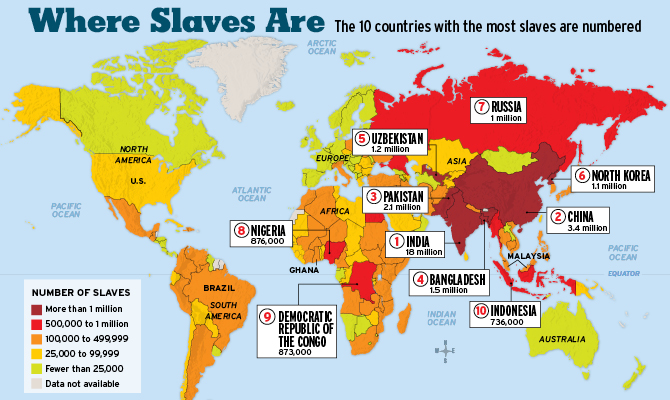
Countries with most slaves. As we can see, slavery is practiced in most countries. I think that slavery is a terrible crime against humanity, which unfortunately in my opinion will always exist, because greed lies in a human nature at the expense of the poorest and the most needy.
Summary of the day
This whole day gave us a lot to think about, especially that for the first time in my life I saw weapons and drugs, which additionally were exposed. Everyone who has enough courage or desire for adventure to come to Peshawar, I warmly recommend a trip outside the city including all three places. There is no shortage of attractions there, and for a few thousand rupees a police officer allows to shoot to the target from Kalashnikov in the desert. I wish everyone who comes here a happy and successful adventure, and he will have something to remember for the rest of his life.
That evening we were tired and we went to sleep right after dinner. I would add that food in Pakistan is also much better than in India. There is a lot of meat of all kinds there, while in India there are mainly vegetables prepared in many ways, and cooked in black oil which rushes to the toilet.
On the way to Afghanistan (Khyber Pass)
The next morning I realized that I needed even more rough adventures, that’s why we went on our next trip. This time we went through the Khyber Pass. It’s an area on the border with Afghanistan, where I had to hire an armed policeman, and where a travel permit was also required. Khyber Pass is apparently outside of the Pakistani law, and it’s famous as a road from South Asia to Central Asia. It was this route, through which all troops going to wars always went through. Alexander the Great also led his army through Khyber Pass.
This time we went with the Hussain’s boss, who called himself “prince”. So far everything was done very well, but I think each of our guides lied a little. Our trip was very successful and the closer we were to Afghanistan, the more mountains we saw. Along the way we took many pictures in the position of “an armed robbery”, and how my guide aimed at me while I kept my hands up. It’s a tradition in these region and at the same time an Afghan joke. You can take good pictures in the company of “terrorist suspects”.
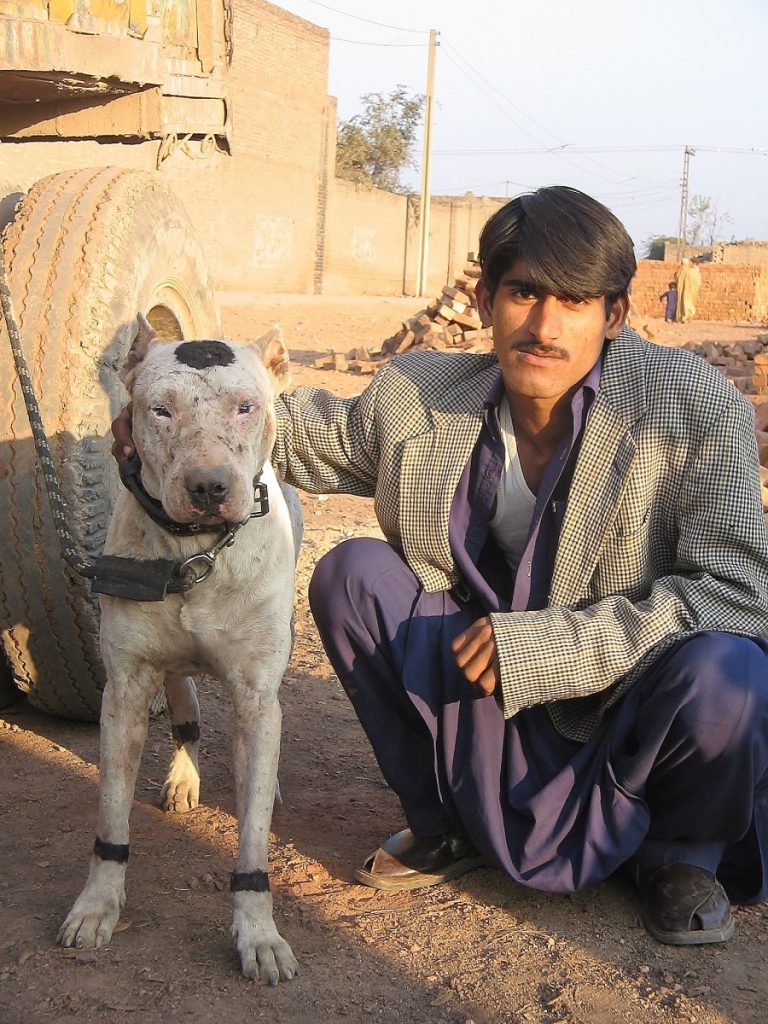 A man with a dog on the way to Afghanistan. |
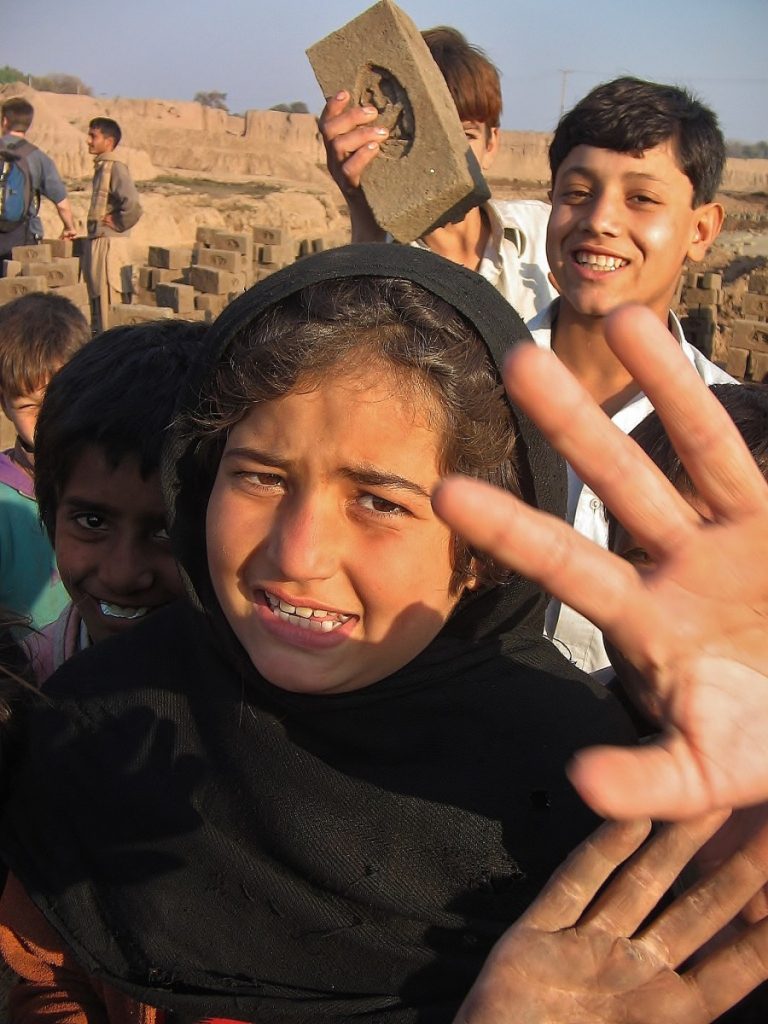 Please pay attention to the girl’s face and the inscription on the brick. |
We were also invited for a green tea and overall it was very nice. On the way, in addition to the mountains we again saw people with Kalashnikovs, but it didn’t affect us. We were only observers, and when we wanted to leave, we always did it with an armed policeman. The whole trip was not just about getting to the border, taking pictures with guns or drinking green tea. Along the way we saw several interesting objects such as Fort Jamrud, Ali Masjid mosque, and even the entrance to the Khyber Pass, the Bab-e-Khyber gate. However, neither the fort nor the mosque liked was as appealing to me as the picturesque serpentine towards Afghanistan, leading through beautiful mountains. Every now and then we also had stops for green tea in the company of armed guards.
I think that the point which “raised the temperature” of the whole trip was the very preparation for it; that is, first arranging the travel permit from the Khyber office, then the company of an armed guard, and the awareness that we were going towards war-torn Afghanistan. Khyber Pass was something special to me, also because of its weight of history.
I was aware that this way Alexander the Great led his army to the Indian Subcontinent, although this route also includes graves of the British soldiers killed in the second war with Afghanistan. After about an hour drive, passing through the border town of Torkham, we reached the border point called Michni. Michni checkpoint is the last place before the Pakistani-Afghan border, for those travellers who do not enter Afghanistan. The view was beautiful, and from the top, where we stood, we saw the mountains of Afghanistan, the Pakistani-Afghan border, and trucks loaded with food heading for Kabul. I also saw that right on the border, but on the Afghanistan’s side there was a camp of Afghan refugees, who were trying to cross into Pakistan.

During my trip around Khyber Pass with my travel agents. After getting permission, you should always be accompanied by a Khyber Rifles member.
I think we both felt very good in that moment, knowing that we were only a step away from Afghanistan. It was an adventure with a thrill, which made us happy because we got so far. On the way back we continued to watch the mountains, and after about an hour drive we returned to Peshawar. I kept our travel permit As a souvenir, and as proof that we were able to go to that special place on that day – Khyber Pass!
Peshawar – last day
(Peshawar Museum, conversations with the locals, hatred of America, 9/11, Osama bin Laden, and even more green tea)
We had almost all day in Peshawar, and that’s why we decided to wander around the town and go to the local musem. As usual in Pakistan, as well as in India or Sri Lanka, foreigners pay more, but I managed to buy two tickets for the price of one. This red-brick Victorian building houses the Ghandaharu art collection, including statues and paintings of Buddha’s life. It must be remembered that for centuries Peshawar has been on the path of crossing cultures and religions, of which the traces have remained here to this day. It was ruled by the Mughal Empire, the Kingdom of Ghandahar, by Sikhs and the British, and earlier it had been conquered by the famous Macedonian – Alexander the Great.
After leaving the museum I once again experienced the Pakistani kindness. When walking across the bustling street and passing a stand with false IDs of Afghan citizens, I was given a few cakes in the store as a present, and then went with Hussain for dinner. I noticed that all Pakistanis loved to talk about political issues. The norm over there is that everyone hates America, and they think George Bush is the biggest terrorist in the world. Everyone is also convinced that Americans also want to invade Iran, and that it is only a matter of time. They said that America never attacks anyone who has the atomic bomb, and that’s why countries such as North Korea, China or Pakistan will not be attacked by America. There are also those (mainly from Afghanistan) who think that Saddam Hussein was a very good man. Many also think that Osama Bin Laden works for America and that’s why he is safe, and that the terrorist attack in New York was just an American provocation.
Because everyone was very interested in what the only white man thought about all of that, I gave them my point of view. Well, I replied to the Pakistani and Afghan people that in my opinion America, and specifically the CIA and MOSSAD organized the attack on two towers in New York by themselves, in order to put the Muslim countries around Israel in a great feeling of guilt. I said that when I watched the video from that terrorist attack, I saw that the two towers collapsed in such a way as if they were blown up from below. In addition, the buildings around the two towers, which planes didn’t, also collapsed. Engineers specializing in building skyscrapers also spoke on that subject, and according to them the impact of those two planes could at most cause fire in the upper parts of the buildings, but not blowing up several buildings which had nothing to do with the impact. Apart from that, America has such a good technology that it sees planes flying at the end of the world, but for some reason it didn’t see two planes that entered the New York’ airspace, like a knife into warm butter. In my opinion, this is a story for naive children. I said: you Muslims could be accused of many things, but definitely not about 9/11. I added that: Israel can be strong only through the weakness of the neighboring countries, while the benefits that came from propaganda and oil have long exceeded the price of the two towers. I also said that: it doesn’t matter if Osama bin Laden works for America or not. Once in a while Americans create and finance Muslim terrorists, and then they get rid of them when they don’t need them anymore. I added: if Israel was on the island of Madagascar, and if Muslims instead of producing oil were only breeding goats, then the 9/11 would have never happened, and in America no one would even hear about Muslims.
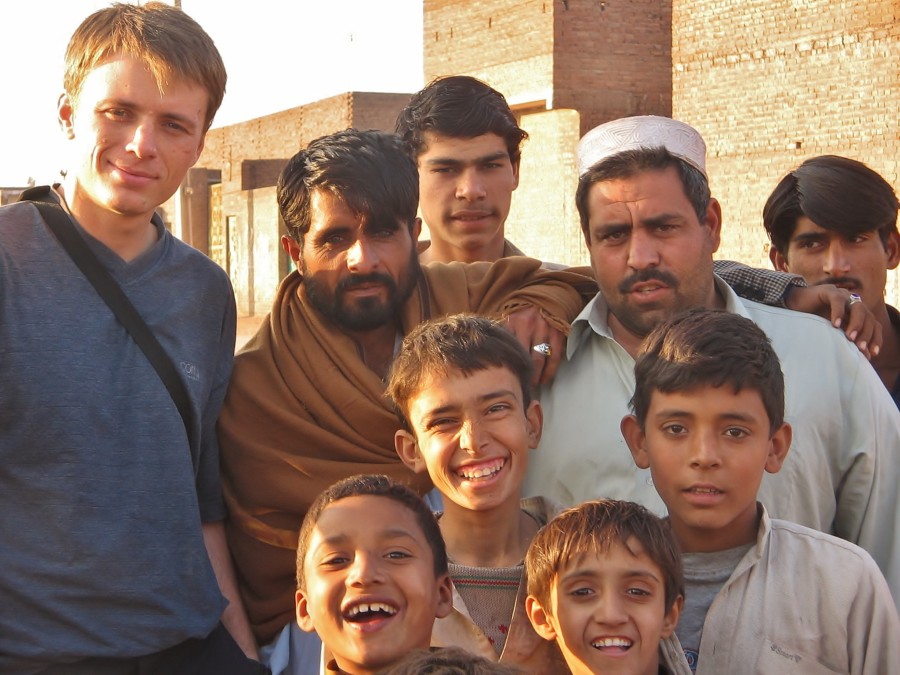
With unforgettable people of Afghanistan. Pakistan.
In Peshawar everyone loves political subjects, but especially Afghans. I met of them there, and everyone wanted to sell me something. Once even an Afghan paid for my tea and then invited me to his carpet store. I also met those who wanted to take me to Afghanistan, but I couldn’t just go there with a man who I met on the street. There were many places in the streets of Peshawar where people produced permanent residence cards for Afghans. Once also my rickshaw driver was from Afghanistan. Everyone was very nice and hospitable, and everyone was disgusted with America. In remembrance of this very interesting place, I bought a rug of goat wool, and a hat and gloves made of the same material. For a few rupees one can come across some good offers and dress up with style, according to the local fashion of course.
Pakistani and Afghan courtesy also had its other side, because even those who bought me tea, reminded me that I will burn in hell, because I was not a Muslim. Apart from that, seeing a white man is an even over there.
I also noticed one interesting thing about the racial issue of the region. Well, Pakistanis generally have darker skin than Afghans, though not always. However, the most interesting to me in this respect were people who originated from the border area of Pakistan and Afghanistan, and had white skin, light eyes and light hair. I asked a few people how it was possible, and they replied that such people in that region also occur, and they are called the descendants of Alexander the Great Macedonian. I therefore think that carrying out genetic research in that region on racial basis would be a very good idea.
The summary of trough through Khyber Pass
Peshawar and everything I saw around it was definitely worth visiting. The route to Afghanistan, the smugglers bazaar, the brickyard of Afghan refugees and even green tea were great elements of my trip. All these experiences against the background of multi-coloured trucks are truly unforgettable.

View of the mountains of Afghanistan, from Pakistan.
I hope that because of this short article I was able to expand the thinking horizons of the future travellers. I realize that this type of “extreme tourism” is not for everyone, but in the perspective of time, I very fondly remember my adventures to destinations, which are not on the list of the most happily visited places. I also think that in this case the natural continuation of my journey should be also the route from Kabul to Peshawar, followed by the scenic Karakoram Highway.



